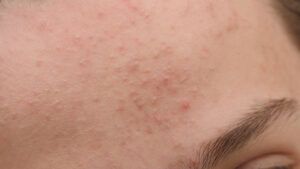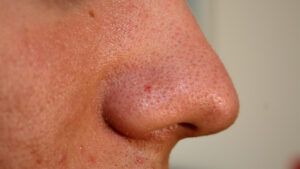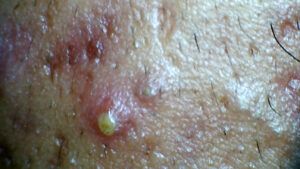Experts recommend not attempting to remove whiteheads. However, if a person wants to remove a whitehead at home, proper hygiene and using extraction tools can help.
Acne is a common skin issue. It generally begins during puberty, when sex hormones cause changes in the body. While acne may taper off as the body adjusts to these sex hormones, acne can persist into adulthood. Approximately 85% of people in the United States experience acne at some point.
Whiteheads are a form of acne that stays under the skin but produces a raised white bump. Acne breakouts commonly occur on the face, back, chest, and sometimes the neck and shoulders.
These blemishes tend to appear in areas with larger concentrations of sebaceous glands, the glands responsible for creating the skin’s sebum, or oils.
Whiteheads can have many causes, including increased sebum production and shedding cells in the hair follicles. Androgen hormones, also known as reproductive hormones, play a role, which explains why acne is widespread in puberty.
Clogged pores can develop when the sebum cannot reach the surface of the skin and gets stuck. As more sebum builds up behind the clogged pores, whiteheads appear.
Other causes include diet, perspiration, and reactions to certain skin care products and fabrics.




It is tempting to remove an individual whitehead. However, it is best to use extraction tools to pop a whitehead, as improper removal may leave an unsightly or painful mark.
Picking or popping whiteheads may cause more harm in the long run. Using fingers to pick a whitehead transfers dirt and oil to the area from the hands, which may lead to more clogged pores and subsequent whiteheads.
Additionally, popping or picking the whitehead is likely to break the skin open. This can leave an open wound that bacteria can enter, causing an infection. The surrounding skin may also become inflamed and irritated, and the wound may lead to scarring.
It is better to avoid removing the whitehead unless a skincare professional can help. Popping a pimple can typically do more harm than good to the skin.
If it is absolutely necessary to remove a whitehead, it is important to be as clean as possible and avoid damaging the skin.
Some general tips for whitehead removal include:
- Apply a warm compress or steam to the area beforehand to help open the pores.
- Clean the hands thoroughly before attempting to pop the whitehead.
- Use small cotton pads or swabs to prevent extra oil from getting on the skin.
- Apply gentle pressure to both sides of the whitehead to get it to pop, and stop if the whitehead does not pop with this gentle pressure.
- Rinse and cleanse the area after popping.
Learn more about popping pimples.
Instead of picking and squeezing whiteheads, a dermatologist may recommend using treatments that help remove whiteheads in their early stages or prevent them from developing in the first place.
Treatments vary because everybody’s skin is different. Individuals can try to work out their skin type and find products and home remedies that best suit them.
When using any remedy for whiteheads, it is important to use a good sunscreen before exposing the skin to the sun. Many home treatments for acne can sensitize the skin to light. Wearing an oil-free sunscreen helps prevent sun damage.
The following sections describe some general whitehead treatments and home remedies.
Witch hazel
Witch hazel is a natural astringent that helps the skin cells to shrink and dry out extra oil. Witch hazel can also have an antibacterial effect, helping remove some of the bacteria that lead to breakouts.
Some people may find witch hazel helpful in their skincare routine. However, it does dry out the skin, so it may not be right for regular use or for skin prone to dryness.
Learn about remedies for dry skin on the face.
Honey
Raw honey is anti-inflammatory, antimicrobial, and an antioxidant. It may help reduce redness from acne, as well as kill and prevent the bacteria that thrive in or cause acne.
After washing, apply raw honey to clean skin and leave it for 15 to 20 minutes before rinsing off and continuing with the skin care routine.
Tea tree oil
Tea tree oil has antioxidant, anti-inflammatory, and antimicrobial properties. A 2019 review notes that tea tree oil is effective for mild to moderate acne, and most people tolerate it well.
It is necessary to dilute tea tree oil to 1% for use on the skin. Either find a product with mild ingredients that also includes tea tree oil or make a heavily diluted mixture at home from pure tea tree oil. Apply it to the skin as part of a regular skin care routine.
Learn more about how to use tea tree oil on the skin.
Aloe vera
Aloe vera is a gel-like substance from the aloe vera plant. It may soothe acne-prone skin, help eliminate bacteria, and prevent scarring.
Aloe vera may also help treat mild to moderate acne. Research from
Look for pure aloe vera, or find products that contain aloe vera along with other non-irritating ingredients.
Learn more about aloe vera for the face.
Lemon juice
Lemon juice contains an acid that dries out the skin and removes extra oils. Fresh lemon juice also contains antibacterial compounds.
Apply lemon juice mixed with water to the skin with a cotton pad. Leave it on the skin for 15 to 20 minutes before rinsing off. It may be best to test on a small patch of skin first to be certain the lemon juice is not too harsh for sensitive skin.
Learn more about lemons and their health benefits.
Salicylic acid
Salicylic acid is an astringent, found in many over-the-counter (OTC) products designed for acne. Salicylic acid works against whiteheads in the following ways:
- soaking up excess oil and drying out oily skin
- reducing oil production
- helping push particles clogged in the pores toward the skin’s surface
- getting rid of dead skin cells
Many OTC products, creams, and washes contain salicylic acid. Try to choose a fragrance-free product with mild ingredients.
Learn about using salicylic acid to treat acne on black skin.
Benzoyl peroxide
Benzoyl peroxide is another OTC remedy for acne. The compound has anti-inflammatory and antibacterial properties that can help dry excess oil from the skin and keep pores unclogged.
A number of OTC washes and toners for acne contain benzoyl peroxide. It may also help to start with lower concentrations, as benzoyl peroxide can be harsh or too drying for some skin types.
Retinol and vitamin A
Topical retinoids may reduce skin inflammation and promote healthy skin cell growth. Doctors may recommend prescription-strength retinoid treatments for acne.
Retinols are generally more mild versions of retinoids, making them safer for regular use.
Choose retinol products with mild ingredients. Start by using the product every few days to build up tolerance before increasing the frequency of use.
Alpha hydroxy acid (AHA)
Alpha hydroxy acids (AHA) are found in many OTC acne products. They are primarily exfoliants, meaning they help remove dead skin cells and clumps of keratin. This may help avoid the clogged pores that lead to whiteheads.
AHA types can vary and may include individual acids such as:
- lactic acid
- glycolic acid
- citric acid
- tartaric acid
The acid types may vary in their exfoliating properties and potency. Test AHA products on a small patch of skin to check for a reaction before moving on to a larger area.
Learn how to exfoliate skin on the face.
Apple cider vinegar
Raw apple cider vinegar is a naturally acidic substance, containing acetic acid and other acids. It has astringent properties that help to dry out extra oil in the pores and shrink their size.
However, apple cider vinegar can be very harsh on the skin. It may be necessary to dilute it with 75% water or more. Even then, it may be too harsh for some skin types.
Read more about home remedies for whiteheads.
The following strategies can help to treat and prevent acne breakouts:
- Washing the skin gently with mild soap and lukewarm water twice per day.
- Pat the face dry rather than rubbing.
- Avoid squeezing pimples or touching the skin unnecessarily.
- Use caution when shaving.
- Avoid excessive sun exposure that could cause tanning or burns.
- Use oil-free, noncomedogenic skin care products, which do not clog the pores.
- Use cosmetics sparingly.
- Remove makeup before going to bed.
- Use fragrance-free, water-based emollient products to treat dry skin.
- Wash the hair regularly and keep hairspray away from the face
- Wear loose clothing made of natural fabrics such as cotton, linen, and hemp.
- Maintain a healthy diet with less sugary and high sodium food or drinks.
Acne can cause long-term scarring and emotional distress. Anyone concerned about their acne should seek the help of a medical professional or dermatologist, as there may be a treatable underlying health issue.
Researchers believe that changing hormone levels may impact the functions of the sebum gland, leading to issues such as sebum retention, increased sebum production, and inflammation.
These fluctuations can occur due to puberty, menstruation, or pregnancy, or because a person has finished a course of oral contraceptives.
Other factors that may aggravate acne include:
- foods with high glycemic numbers
- foods high in hormones, such as dairy products
- oil-based cosmetics
- facial massage with oils
- premenstrual flare-ups
- anxiety and anger, likely from stress hormones
Acne can also result when clogged pores become infected with the bacteria Propionibacterium acnes (P. acnes), which occurs naturally in the skin.
Factors that can worsen acne include:
- certain medications
- contact with sports equipment
- wearing backpacks, tight bras, or sports uniforms
- pollution
- excessive sweating
- popping pimples
- harsh skincare practices, such as rubbing the skin too hard
- lack of washing
Learn about acne face maps.
Both whiteheads and blackheads are types of acne blemishes called comedones. There are two common types of comedones: open and closed.
A whitehead is a closed comedone. It results from clogged pores under the skin’s surface, causing sebum to build up behind it and making a raised, white bump appear.
A blackhead is an open comedone. Blackheads appear due to a plug of the sebaceous pore on the skin’s surface, but the pore itself is still open.
People may use “pimple” to describe both whiteheads and pustules.
While they share some similarities, they are not the same thing. Both issues arise due to a clogged pore, as oil, bacteria, and skin cells block the pore.
However, in a pustule, the walls of the pore start to break down. Because of this, the pustule may be bigger than an average whitehead. It may also have a yellowish color. The area around a pustule may be hard, red, and tender to the touch.
Whiteheads occur when pores get clogged with sebum, which builds up and causes a white bump to appear on the skin’s surface.
It is best to avoid popping whiteheads, which can spread dirt, oil, and bacteria. It can also lead to further irritation and scarring.
Home remedies for whiteheads focus on preventing them. They include exfoliating the skin, removing extra oil from the pores, and killing bacteria. Products containing tea tree oil, witch hazel, or salicylic acid may also help.

